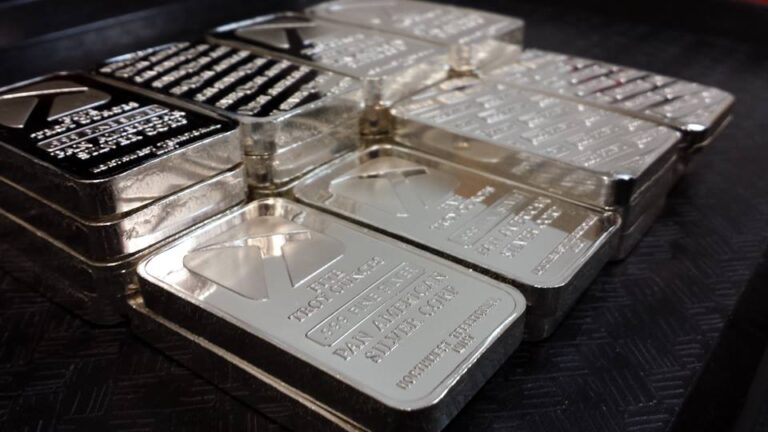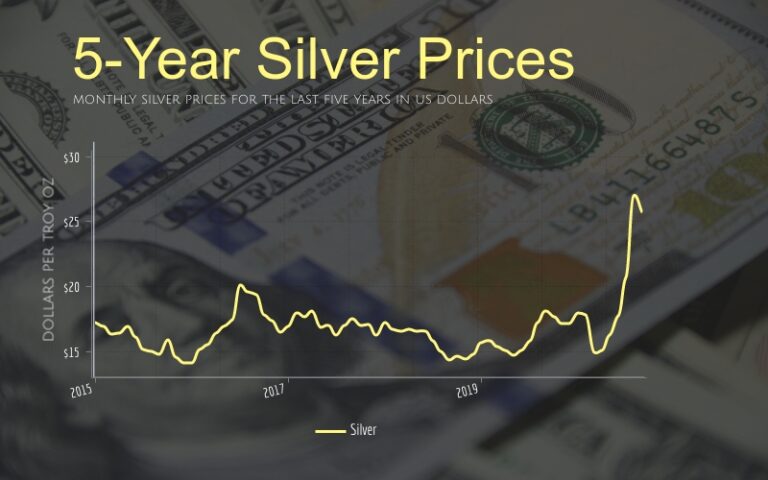Historical Silver Price Per Ounce

Silver, a precious metal with a long history of use and investment, has been valuable since ancient times. Throughout history, silver prices have fluctuated due to a variety of factors including the availability of physical supplies, changes in demand, and manipulation by governments and financiers.
This article will explore the historical silver price per ounce from ancient times to the present day. It will examine various factors which have influenced its value over time as well as long-term trends in silver prices.
Factors Influencing Silver Prices
A variety of factors have had an impact on the fluctuation of silver prices. The first and foremost factor is the demand and supply of silver. Demand for silver usually increases when it is used in manufacturing, jewelry making, or other industrial use cases. On the other hand, if there is a decrease in its demand then this has a direct effect on its price in terms of depreciation. Similarly, if there is an increase in the production of silver then this results in more availability and a subsequent decrease in its price per ounce.
Additionally, geopolitical events can also affect the flux of silver prices significantly. Silver prices have been known to rise due to wars or political instability as investors take refuge from volatile stock markets by investing their money into commodities like gold and silver instead.
Economic events such as recessions can also influence fluctuations in silver prices because investors are likely to move away from stocks during times of economic uncertainty and focus more heavily on commodities that hold value such as precious metals like gold and silver to hedge against market volatility.
Long-Term Trends in Silver Prices
Examining long-term fluctuations in the cost of silver can provide insights into its overall value. Since 1971, when the U.S. dollar was decoupled from gold, silver prices have generally shifted from one extreme to another without much consistency in between.
In the early 1970s, silver traded for around $2 per ounce and then moved into a period of high volatility with prices fluctuating wildly before reaching a peak of nearly $50 an ounce at the end of 1979. It then fell sharply over the next decade until bottoming out at just under $5 an ounce in 1991.
Since that time, silver has generally been on an upward trajectory, reaching highs of more than $30 an ounce during 2006 and 2011 before dropping off again and settling at around $17 per ounce in 2018. Despite these fluctuations, there is no clear long-term trend: some periods have seen sustained increases while others have seen sharp falls.
However, overall prices appear to remain within a relatively narrow range compared to those seen prior to 2000. This suggests that recent trends may not be reflective of future movements and caution should be taken when making predictions about silver’s future price movements.
Silver Prices in Ancient Times
Silver has been a valuable commodity for millennia, with evidence of its use as currency dating back to the ancient Greek and Roman empires. During this time period, silver was worth around 10 times more than gold on an ounce-for-ounce basis, according to archaeological records.
The value of silver fluctuated throughout ancient history based on several factors:
- It was used as a medium of exchange in economies where coins were not yet available
- Its rarity made it more desirable than other metals
- Its malleability allowed it to be easily shaped into coins or jewelry
In many cases, ancient civilizations would pay tribute or taxes in silver due to its high value relative to other commodities. Silver’s importance in society can be seen in the fact that its use as currency was widespread during this period.
Furthermore, silver had significant religious and spiritual significance for many cultures, which further contributed to its status as a precious metal. Ancient peoples believed that silver possessed magical powers and could ward off evil spirits. Consequently, some rulers minted their own coins out of pure silver for ceremonial purposes or even buried them in tombs alongside their deceased relatives.
Silver Prices in the Industrial Age
The Industrial Age saw an increase in the global demand for silver, as industries such as jewelry-making and photography began to rely on it. This increased demand had a positive impact on the price of silver, with prices increasing significantly between 1800 and 1900. During this period, the average price of one ounce of silver rose from around $0.90 to over $1.20 per ounce in some parts of Europe.
In addition, due to improved industrial processes and other technological advances during this period, more silver was mined than ever before. This allowed these same industries to purchase larger amounts of silver at lower prices than ever before, further increasing its global popularity and driving up its market value.
As a result, by 1900 the average price of one ounce of silver had risen to nearly $2 in some regions of Europe.
Silver Prices in the Modern Era
In the modern era, advances in technology have made silver an increasingly attractive investment opportunity for many investors. Silver prices have been on a steady rise since the 2000s and remain at historically high levels today. The primary factor behind this trend is increased demand from industrial applications such as electronics. As technological advances continue to drive up the cost of production, silver has become an essential component in many everyday gadgets and products.
Additionally, silver is seen as a safe-haven asset during periods of economic uncertainty or market volatility, making it more appealing to investors looking for a reliable form of security. Another major contributor to recent increases in silver price is growing investor interest due to its status as one of the most affordable precious metals available on the market today. ETFs and mutual funds that invest in silver are becoming increasingly popular tools for diversifying portfolios with minimal risk.
Furthermore, with advancements in digital technologies allowing for faster transactions and low transaction costs, it has become easier than ever before to invest in physical silver through online platforms like Bullion Exchanges. All these factors combined make investing in silver an attractive option for many individuals looking to diversify their portfolio or hedge against inflationary pressures.
Frequently Asked Questions
What is the current price of silver per ounce?
The current price of silver per ounce is determined by a variety of factors, including supply and demand dynamics, macroeconomic conditions, geopolitical events, and investor sentiment.
On the supply side, mining companies play an important role in setting the market price for silver. The cost of production for these companies can also influence prices.
On the demand side, industrial and jewelry usage are two major drivers of silver prices. Additionally, investors have become increasingly interested in precious metals as a store of value and hedge against inflation in recent years. As such, their buying activity has had a significant impact on the current spot price level for silver.
How can I invest in silver?
Investing in silver can be a profitable venture for those looking to diversify their portfolio. According to the World Silver Survey, global demand for silver increased by 3% in 2019 with an estimated total of 1,072 million ounces being purchased across all sectors. As such, it is increasingly becoming a popular choice amongst investors who are interested in investing in precious metals.
There are various methods of investing in silver which include buying physical bullion or coins, futures contracts and exchange traded funds (ETFs). Physical bullion or coins provide investors with tangible assets that can be stored and sold later on when prices rise. Futures contracts allow investors to buy or sell an agreed upon amount of silver at a predetermined price at a specific future date. ETFs offer exposure to the price movements of physical silver without having to own actual physical metal, making them relatively cost efficient compared to other investment vehicles.
Ultimately, deciding how best to invest in silver will depend on individual circumstances and preferences.
What is the difference between silver and gold prices?
Gold and silver prices are two of the most widely followed commodity markets.
Both metals have been used as currency for centuries and remain popular investments today.
While both gold and silver prices tend to be affected by similar macroeconomic factors, there is a significant difference in their trading dynamics.
Gold prices tend to move more steadily than silver due to its higher demand for use in jewelry, electronics, and other industrial applications.
Silver also has numerous industrial uses including photography and electronics components; however, it is more heavily influenced by supply/demand dynamics due to its widespread availability in coins or bullion form.
Gold typically trades at a premium compared to silver due to its higher perceived value.
What are the current silver price predictions?
Silver is often seen as a metal of mystery, its price remaining elusive and unpredictable. Analysts have recently predicted that silver prices will rise significantly in the coming months due to increasing demand for industrial applications such as solar energy, medical equipment, and electronics.
In addition, investors are hoping that the ongoing economic uncertainty will lead to increased safe-haven investments and further boost silver prices. With both industrial and investor interest on the rise, it remains to be seen whether silver prices will continue their upward trend or if they are set for a reversal in the near future.
What is the best way to store silver?
The best way to store silver is to keep it in a cool, dry, dark location. Silver should be stored away from any source of moisture and light, such as windows or areas of high humidity. It’s also important to avoid storing silver near any corrosive substances, such as saltwater or acids.
Ideally, the storage area should have a low relative humidity and temperature range between 40°F and 70°F (4°C – 21°C). To help protect the silver from tarnishing, it is recommended that the container be lined with anti-tarnish strips or tarnish-resistant paper. Additionally, items can be wrapped in acid-free tissue paper before being placed in an airtight container for further protection.
Conclusion
Silver has been a precious commodity throughout the ages, representing wealth, status, and power. The price of silver is determined by a variety of factors, including industrial demand, currency values, and investment speculation.
The long-term trends in silver prices can be likened to a roller coaster ride – sometimes soaring to dizzying heights and other times plummeting into great depths. The historical price of silver offers insight into how its value has changed over time; from ancient times when it was used as a form of payment and as an indicator of wealth, to modern times when industrial uses have increased its demand and driven up its cost.
Silver remains an important part of our economic landscape today, with its supply and demand continuing to affect the markets in both predictable and unpredictable ways.






